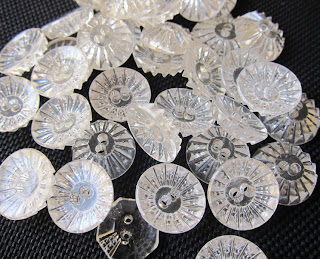I never had much interest in buttons, until I started making jewelry out of vintage things. Then the whole world of buttons opened up to me. My grandmother had a big jar of buttons which became goods and money in my play shops as a child and stacking them, coding them by colour and type and making vast landscape patterns on the kitchen table became fond childhood activities. Now, every time I see a jar of buttons in a flea market, my heart does a little jump.
What intrigues me is the detail and fine craftsmanship of many rare buttons. In New York a few years ago I bought a handful of very expensive Victorian mourning buttons from a dealer. They were jet black and carved intricately with patterns and flowers and were like miniature wall plaques. Indeed, in the history of buttons, I read that buttons were originally artifacts and were used as seals before they became fasteners. They have been a small but significant part of human life for 2000 years.
http://www.etsy.com/listing/78887934/antique-vintage-brass-and-blue-celluloid
http://www.etsy.com/listing/77034204/vintage-mid-century-large-clear-lucite
The buttons I list on etsy are there because I see their potential as jewelry. They are as beautiful as any bead but have the added advantage of being vintage which means they are unlikely to be seen elsewhere. Fashion in buttons change and match the values of each era's need for uniqueness. Fashion helps us express ourselves individually, but the social implications have not been discussed by serious scholars.
There is a French philosopher called Gilles Lipovetsky who has written a book about how fashion trends influences us in more ways than the superficial.
In 'The Empire of Fashion: Dressing Modern Democracy', he argues for a more in depth look at fashion and how it fits into culture.He suggests that fashion being the realm of superficiality fosters tolerance of difference between different groups in society and therefore it has an important role to help smooth over conflict.
When we recycle old fashion like buttons and make new fashionable items we are not only helping foster tolerance to different social groups, but perhaps also to times.
You could argue that buttons as integral to fashion, become in this way, kinds of fasteners for social groups current and past as well as for actual material things.

























